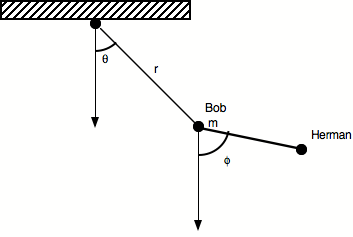Classical Mechanics
11/12/2007
Stanford
class with Leonard Susskind.
Example: Simple pendulum

Velocity:
![]()
Kinetic energy:
![]()
![]()
Potential energy:
![]()
Potential energy is at a minimum when ![]() .
.
The Lagrangian is:
![]()
Angular momentum is:
![]()
The Euler-Lagrange equations are
![]()
![]()
![]() is constant, so
the equations of motion are
is constant, so
the equations of motion are
![]()
Calculate the Hamiltonian
The Hamiltonian is the total energy.
![]()
Specifically, for the pendulum,
![]()
Substituting
![]()
Example: the double pendulum
The double pendulum has two “bob’s”, in this case “Bob” and “Herman”.

Kinetic energy of Bob:
![]()
Velocity of Herman:
![]()
Add the velocity of Herman with respect to Bob to get the velocity of Herman.
Kinetic energy of Herman:
![]()
Sum of the kinetic energies of Bob and Herman is:
![]()
The sum of the potential energies of Bob and Herman is:
![]()
The Lagrangian becomes:
![]()
No conserved quantity under the force of gravity.
Conserved quantities with no gravity
However, investigate ![]() case (no
gravity):
case (no
gravity):
Noether symmetry
![]()
![]()
then

Total angular momentum should be conserved.
![]()
Calculate the equation of motion for ![]() .
.

Example: simple harmonic motion
Approximate:
![]()
Substitute into the Lagrangian for simple harmonic motion, and drop the constant term.
![]()
Use the variable “x”. Consider a spring.
x=0 at equilibrium.
The potential energy is the work done against the spring from equilibrium.
![]()
“k” is the spring constant.
The force exerted by the spring is (Hooke’s Law):
![]()
The Lagrangian for simple harmonic motion is:
![]()
![]()
The Euler-Lagrange equations are (F=ma)
![]()
![]()
Let
![]()
then
![]()
Substitute:
![]()
The Sine is also a solution. In general, the solution to this second order equation is:
![]()
A specific solution requires the initial position and velocity.
Another way of putting the solution
![]()
where ![]() at
at ![]() .
.
Construct the Hamiltonian.
![]()
![]()
![]()
is conserved.
Consider the Hamiltonian formulation
Instead of ![]() use
use ![]() . Solve for
. Solve for ![]() in terms of
in terms of ![]() .
.
![]()
![]()
Hamiltonian mechanics is symmetric between x and p.
Phase space

![]() is conserved.
is conserved.
Therefore, the shape of the trajectory in phase space is
that of an ellipse. ![]() is the square of
the semi-major and minor axis.
is the square of
the semi-major and minor axis.
![]() when
when ![]()
What is the period of the orbit? It is the frequency ![]() . All the elliptical orbits are repeated with frequency
. All the elliptical orbits are repeated with frequency ![]() .
.
Phase space is fundamental. An orbit in phase space is a contour of constant energy. Area in phase space is preserved in time. In quantum mechanics this is “unitarity” or conservation of probability.